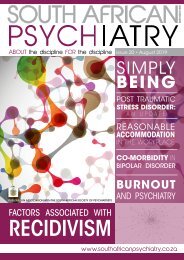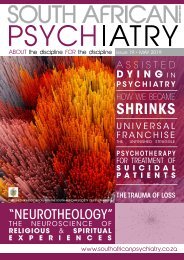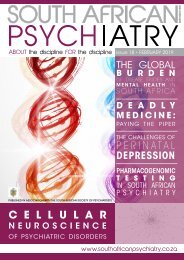South African Psychiatry - November 2020
South African Psychiatry - November 2020
South African Psychiatry - November 2020
Create successful ePaper yourself
Turn your PDF publications into a flip-book with our unique Google optimized e-Paper software.
WITS JOURNAL OF CLINICAL MEDICINE – REPUBLICATION
virus, inability to regulate uncertainty, limited social
interactions, unsafe living conditions, and economic
fallout, among others. 8,9 While these symptoms
might not constitute an anxiety disorder per se, they
are currently among the most common symptoms
emerging during the COVID-19 pandemic. 2,3 A
possible worsening of symptomatology in preexisting
cases is described in the literature. 9 Here we
describe some of the most frequent presentations
of anxiety during the pandemic, however we do not
comprehensively discuss anxiety disorders as this
has been a major focus of the existing psychiatric
literature on COVID-19. Further information about
anxiety disorders during COVID-19 has been
reviewed elsewhere. 9
GENERALISED ANXIETY DISORDER
IS AMONG THE MOST FREQUENTLY
DESCRIBED PRESENTATIONS AMONG
COVID-19 PATIENTS. A META-ANALYSIS
OF SARS, MERS, AND COVID-19 STUDIES
REPORTED THAT ANXIETY WAS COMMON
IN THE POST-ILLNESS PHASE UP TO THREE
YEARS AFTER INFECTION. 2
A cross-sectional survey performed in China
reported a relatively high prevalence of generalised
anxiety disorder of 35.1%, particularly among
patients below the age of 35 years and those who
reported excessive rumination (≥3 hours a day)
about the pandemic. 11 In one recent study on
the mental health impact of COVID-19 in Soweto,
while a majority of adults perceived that COVID-19
did not affect their mental health, a variety of
stressors that caused deep worry, anxiety, and
rumination (“thinking too much”) were reported
in approximately 20% of adults. 8 These concerns
during the lockdown were driven and exacerbated
by the inability to care for themselves and their
families, crippling economic struggles, personal
vulnerability due to illness, the invisible nature of
COVID-19 transmission, and a lack of awareness on
the disease.
As described above, health anxiety is another
common presentation seen during the pandemic 9
and may result in individuals seeking medical
assistance repeatedly, or conversely, avoiding
help seeking behaviour even when unwell. Health
anxiety may also result in a mistrust of or reluctance
toward engaging health authorities. 10 These anxiety
related behaviours may be erroneously attributed to
an anxiety disorder and impart an added pressure
on the already overburdened mental health system
in South Africa.
PANIC ATTACKS MAY ALSO OCCUR AS A
DISTINCT DISORDER OR IN COMBINATION
WITH OTHER PSYCHIATRIC DISORDERS.
There is a paucity of literature regarding this
in relation to COVID-19. However, panic attack
symptoms such as shortness of breath, chills or
heat sensations, and chest pain or discomfort
may overlap with symptoms of COVID-19 infection.
Individuals with pre-existing panic disorder or who
experience panic attacks from any other medical
or psychiatric disorder might experience panic
attacks more frequently. New onset of panic attacks
in individuals with other psychiatric diagnoses is
also possible.
OBSESSIVE COMPULSIVE DISORDER (OCD)
Another prominent presentation in the COVID-19
environment, by virtue of the clinical symptoms of
distinct thoughts and often linked behaviours, is
obsessive compulsive disorder. This disorder was
previously categorised under anxiety disorders and
now exists as a separate category (OCD and related
disorders) in the DSM-5 and can lead to significant
functional impairment. 1 Numerous countries (e.g.
China, United States, United Kingdom, Italy, India)
have shown a recent increase in outpatients
presenting with OCD symptoms, with exacerbation
of symptoms such as hoarding and washing
compulsions in already diagnosed OCD patients
in response to stressors in the environment. 11,12
Lockdown measures may lead to panic buying
and hoarding items such as hygiene products, flu
medication, and groceries. 11 Patients may struggle
to determine what constitutes excessive behaviour
under these extraordinary circumstances and
normalise their compulsions as a precautionary
response to the global pandemic. Proper hand
washing techniques recommended may also
reinforce ritualistic behaviours, another clinical
feature of OCD.
THE INFLUX OF INFORMATION FROM TV,
NEWSPAPERS AND SOCIAL MEDIA SITES
REGARDING THE VIRUS CAN ADD TO
OBSESSIONS ABOUT CONTAMINATION, 12
DURING PREVIOUS EPIDEMICS SUCH
AS SARS, MERS AND INFLUENZA,
RESEARCHERS REPORTED A WORSENING
OF OCD IN PATIENTS UP TO ONE YEAR
LATER. 12
MOOD DISORDERS
Direct infection of COVID-19 and the collateral
impacts of the pandemic place many at risk for a
variety of mood disorders. Seropositivity for viral
illnesses linked to Influenza A & B and coronaviruses
were shown to be associated with having a history of
mood disorders, including depressive disorders, and
increased suicide attempts. 13 One cross-sectional
survey conducted in China during the COVID-19
outbreak found a prevalence of depressive symptoms
of 20.1% and sleep disturbances of 18.2%. 10 Another
Chinese study conducted during the early stages
of the outbreak, found that 16.5% of the sample
reported moderate to severe depressive symptoms. 14
As noted with the HIV/AIDS epidemic in South Africa,
depression can increase the risk of acquiring the
virus, and the presence of mental illnesses can also
SOUTH AFRICAN PSYCHIATRY ISSUE 25 2020 * 17
















